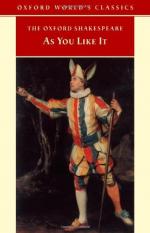|
This section contains 11,261 words (approx. 38 pages at 300 words per page) |

|
SOURCE: Kinney, Clare R. “Feigning Female Faining: Spenser, Lodge, Shakespeare, and Rosalind.” Modern Philology 95, no. 3 (February 1998): 291-315.
In the following essay, Kinney surveys the character of Rosalind from its inception in Edmund Spenser's Shepheardes Calender (1579), to Thomas Lodge's Rosalynde (1590), and finally to Shakespeare's As You Like It. The critic contends that by varying degrees the authors prevent Rosalind from fully expressing herself as an artist through the application of extratextual cultural influences and intratextual strategies of recontainment.
Toward the end of the sixteenth century, three Englishmen create three different versions of pastoral in which they represent a novice poet writing poems to a woman called Rosalind; each work (and in particular the two later ones) also records the woman's response to the lyrics made in her honor. This scenario appears in a cycle of eclogues, a prose romance, and a romantic comedy: Edmund Spenser's Shepheardes Calender (1579); Thomas Lodge's...
|
This section contains 11,261 words (approx. 38 pages at 300 words per page) |

|


